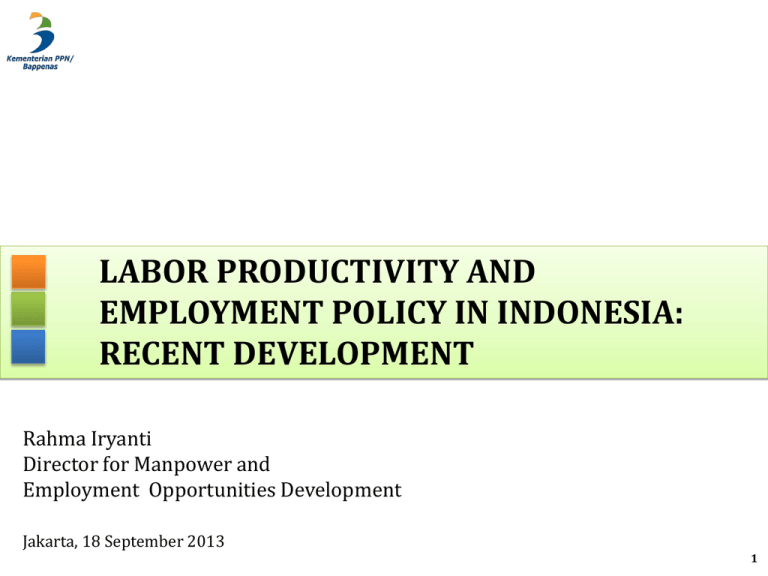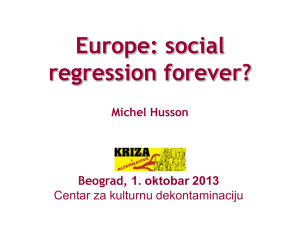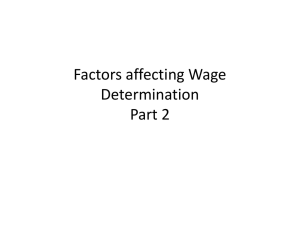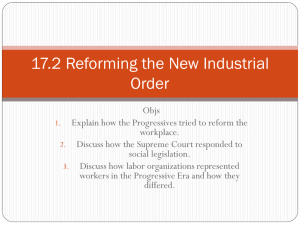Labour Productivity and Employment Policy In Indonesia
advertisement

LABOR PRODUCTIVITY AND EMPLOYMENT POLICY IN INDONESIA: RECENT DEVELOPMENT Rahma Iryanti Director for Manpower and Employment Opportunities Development Jakarta, 18 September 2013 1 OUTLINE • Background: – Current Conditions • Labor Productivity • Current Conditions – Minimum Wage and Production Growth • The Needs of Improvement in Minimum Wage Setting Mechanism • Government Policy: Directions and Steps 2 CURRENT CONDITIONS GDP GROWTH BY SECTOR Source: Statistics Indonesia; *) Quarter III/2012 • Service sector replaced industry since 2005. However, from 2009 industry grows faster and in 2012 growth of industry has exceeded service sector. • We indeed have a “red district” due to 1997 financial crisis, but we are on the track to recover. 3 In most sectors, labor productivity has improved gradually … 25% 20% 15% 10% 5% 0% -5% -10% -15% Agriculture Industry Service 2011 2010 2009 2008 2007 2006 2005 2004 2003 2002 2001 2000 1999 1998 1997 1996 1995 1994 -20% 1993 Labor Productivity Growth Rate (%) LABOR PRODUCTIVITY GROWTH RATE Total • Our labor productivity is growing at around 4,5% rate. • In 2011, the growth is dominated by agriculture sector. 4 … but gains in productivity are slowing 20.0% Average Productivity Growth by Sector in the Last Decade 17.2% 2000-2005 15.0% 2006-2011 10.0% 8.1% 7.8% 5.4% 4.6% 5.0% 5.3% 3.8% 3.6% 3.2% 1.8% 1.5% 3.3% 2.2% 1.3% 0.0% -1.0% -5.0% -4.2% Agriculture, hunting, forestry, fishing Mining & quarrying, utilities Manufacturing Construction Wholesale and Transport, Other Activities retail trade, storage and restaurants and communications hotels Total Source: Indonesia’s productivity – and competitiveness – is lagging behind neighboring countries Value Added per Worker (2005 PPP$) 14,000 1995 12,000 2005 10,000 2010 8,000 6,000 4,000 2,000 Cambodia Mongolia Indonesia Phillippines China Thailand Malaysia Lao PDR Vietnam Source: WDR 2013 core statistical tables, I2 … as well as across most other sectors Value Added per Worker (2005 USD) 2010 Productivity by Sector: Comparing Indonesia with East Asian Neighbors 30,000 25,000 Indonesia Malaysia Thailand Vietnam (2009) Philippines 20,000 15,000 10,000 5,000 0 Agriculture, Manufacturing hunting, forestry, fishing Construction Wholesale and Transport, Other Activities retail trade, storage and restaurants and communications hotels Total Source: CEIC … and in a highly informal labor market, the quality of jobs for most workers is low • The majority of workers are in the informal sector • Over 80 percent of formal workers do not have a contract. • Employees without contracts earn less and are less likely to receive any benefits. Employers 2% Permament contract employees 3% Informal agricultural 27% Informal nonagricultural 27% Employees with no contract 38% Fixed-term contract employees 3% 8 EDUCATIONAL BACKGROUND vs ECONOMIC SECTOR 100% 90% 80% 70% 60% 50% 40% 30% 20% 10% 0% Basic Secondary Higher Share of Employment Source: National Labor Force Survey, Feb 2012, (Bappenas Calculation) • • Almost 40% of employment are in agriculture, but around 90% of workers in this sector are low-skilled. Sectors such as social/personal services; electricity, gas, water; and finance require more skill (higher education). The rest is dominated by people with basic education. 9 Overview: Past Trends of Minimum Wages • • Since 1999, the average of national minimum wage has been increasing with the average of 13 per cent annually. The relatively high increase of minimum wages in certain years has caused uncertainties for business. Minimum Wages of Several Regencies in Banten, 2012-2013 Kabupaten/Kota 2012 2013 Change Minimum Wages of Several Regencies in Jawa Barat, 2012-2013 Kabupaten/Kota 2012 2013 Change Kab. Bekasi 1,491,866 2,002,000 34.19% Kota Tangerang 1,381,000 2,203,000 59.52% Kota Bekasi 1,422,252 2,100,000 47.65% Kab. Bogor 1,296,320 2,042,000 57.52% Kota Tangsel 1,381,000 2,200,000 59.30% Kab. Sukabumi 885,000 1,201,020 35.71% Kab. Tangerang 1,379,000 2,200,000 59.54% Kota Depok 1,424,797 2,042,000 43.32% Kab. Sumedang 1,007,500 1,381,700 37.14% Kab. Subang Kab. Purwakarta 862,500 1,047,500 1,220,000 1,639,167 41.45% 56.48% Kab. Karawang 1,269,227 2,000,000 57.58% Kota Bogor 1,174,200 2,002,000 70.50% Kota Cilegon 1,340,000 2,200,000 64.18% Kab. Serang 1,320,500 2,080,000 57.52% Kota Serang 1,230,000 1,798,446 46.22% 10 Rapid increases in minimum wages may also discourage investment and affect productivity Minimum Wage per Month (USD) 300 250 China Indonesia Philippines Thailand Malaysia Vietnam * 200 150 100 50 0 2007 2008 2009 2010 2011 2012 2013 11 Current Conditions – Minimum Wage Minimum wage has become one of the main worker demands in recent demonstrations. If such condition continues, there will be two major impacts on employment and workers’ welfare in medium and long term: First, minimum wage will grow faster than inflation and productivity. Second, the government intervention on wage setting may hinder the process of collective bargaining between employers and labor unions. Minimum wage setting has become the main mechanism to determine wages and to increase workers’ welfare. The increase of provincial minimum wages since 2007 is no longer consistent with the increase due to inflation, basic requirements of living, and the scale of the wage change itself. Since 2007, surveys to determine minimum basic requirements for living (KHM) have been conducted by regional wage councils. Before 2007, the surveys were conducted by the Statistics Agency. 12 Current Conditions – Production Growth Medium and Large Manufacturing Industries: In general, production of manufacturing industries indicates a positive growth in 2012. However, not all industries show a production increase. Positive Growth Types of Industries Negative Growth Growth Types of Industries Growth Pharmacies 13,19% Basic metal -8,48% Food 12,75% Textile -8,32% Tobacco 5,42% Leather and footwear -6,96% Clothing 4,91% Furniture -6,60% Transport equipment 3,57% Paper -4,37% Road vehicles 3,23% Beverages -0,50% 13 Current Conditions – Production Growth Labor-intensive Manufacturing Industries: There are three labor-intensive manufacturing industries that should be considered, i.e. textile, clothing, and footwear. In 2012, large and medium textile and footwear industries shifted by minus 8,32 per cent and minus 6,96 per cent, respectively. Meanwhile, micro and small industries showed a positive growth, including clothing industries. Type of Industries Medium and Large Micro and Small Q4/2011-Q4/2012 (y-on-y) 2012 Q4/2011-Q4/2012 (y-on-y) 2012 -8,32% -14,78% 2,96% 8,26% Clothing 4,91% 9,14% 4,15% 8,76% Footwear -6,96% -3,18% 8,89% 13,91% 4,12% 11,09% 4,06% 1,89% Textile Manufacturing industries 14 Keep in mind: Principles of Minimum Wages Minimum wages act as the safety net for workers with the lowest income while at the same time increase their purchasing power. “Indonesia has dualistic labor market structure, indicated by high numbers of informal workers and small numbers of formal workers.” “The Government shall set minimum wages based on basic requirements of decent living by taking into account productivity and economic growth.” (Article 88 of Labor Law No. 13/2003) “Minimum wages in Indonesia are used more as a primary wage setting than as a safety net.” (World Bank, Indonesia Jobs Report 2010) 15 Keep in mind: Other Principles Minimum wages cannot be set based on any pressure imposed by either employers or workers. Minimum wage setting must consider other factors such as average wage level, worker’s requirements of living, inflation, productivity, economic growth, available jobs, and capacity of business entities. Indonesia 1,500,000 1,000,000 500,000 2011 2010 2009 2008 2007 2006 2005 2004 2003 2002 2001 2000 0 KHM Indonesia 16 Re-formulating the minimum wage setting process to protect low-wage workers • Improving the minimum wage setting mechanism, so that the process is more predictable and formulaic, and protected from political pressures. • Revise the legal framework. • Use the minimum wage as a floor wage, not for all workers. • Strengthening collective bargaining at the plant level so that workers are not forced to negotiate only in national policy-setting forums. • Differentiate between various industries and types of firms. • Improving non-compliance. • Link to Grand Bargain. Minimum Wage Setting: Improvement by Government – 2014 Onwards The increase of minimum wages in 2014 should be prudently and proportionately set. This is very important considering the current condition of the business, especially SMEs. The Government is willing to ensure that the amount of minimum wage increase in 2014 is determined proportionately with two points of consideration: First is the need to transfer income among worker groups. Such income is essential to safeguard the purchasing power and keep the demand high. Second is to maintain a conducive investment climate. Minimum wages are not allowed to increase in such a high amount that it makes unfavorable impact to investment climate. In order to make sure such matter happens, the change of minimum wages in 2014 must be fair. In medium term, the Government is preparing a draft of government regulation (RPP) on wage policies. It consists of not only minimum wage, but also overall wage policies. 18 Government Policy: Direction 1. Maintaining current available employment (preventing any business closures and worker lay-offs). 2. Improving the quality of employment (e.g. increasing the number of formal employment). 3. The setting of basic requirements of decent living is still based on moving targets. It has not yet considered the productivity improvement factor. Therefore, the productivity improvement factor will be considered as one of the variables used in the formula of minimum wage setting. International benchmarking will also be considered. 19 Government Policy: Direction 4. The Government is considering providing incentives for labor-intensive industries. 5. To improve the purchasing power of workers in agriculture and informal economy, the Government will expand empowerment programs, including labor-intensive programs such as cash for work. Such programs will be targeted to part-time workers, so they will obtain additional incomes. The programs are short term. The most important is to improve the productivity of agricultural sector. 20 Government Policy: Steps for Implementation 1. Determining two categories of wages, i.e. minimum wage and individual wage. The latter is based on negotiations. 2. Indonesia has wage councils as the entities to recommend minimum wages. The councils should be empowered not only to set wages but also to improve the mechanism of wage negotiation in determining individual wages. 3. Improving the quality of human resources. Education plays a very important role in improving productivity and high-quality education and trainings are unquestionably needed. Therefore, the quality improvement of our education in general is a must, while at the same time we need to increase the enrollment rate of higher education. 21 Government Policy: Steps for Implementation 4. Negotiation between two parties at company level becomes an optional mechanism in determining wages. Improvement of bargaining coordination between employers and workers is focused on two-parties negotiation mechanism. In order to make sure both parties can negotiate wages accordingly, a strong relation with the company is needed. Meetings of both parties conducted by employer associations and labor unions to resolve any disputes and other employment issues are strongly encouraged. 5. Be prudent in increasing the level of minimum wages to avoid any problems arising from adoption of high minimum wage rise policy. Some problems have already occurred in Indonesia, such as low compliance of labor standards, slow rise of formal employment when the minimum wages increase, and low number of poor workers moving from informal economy. These problems must be cautiously dealt to avoid further consequences. 22 Thank You 23








